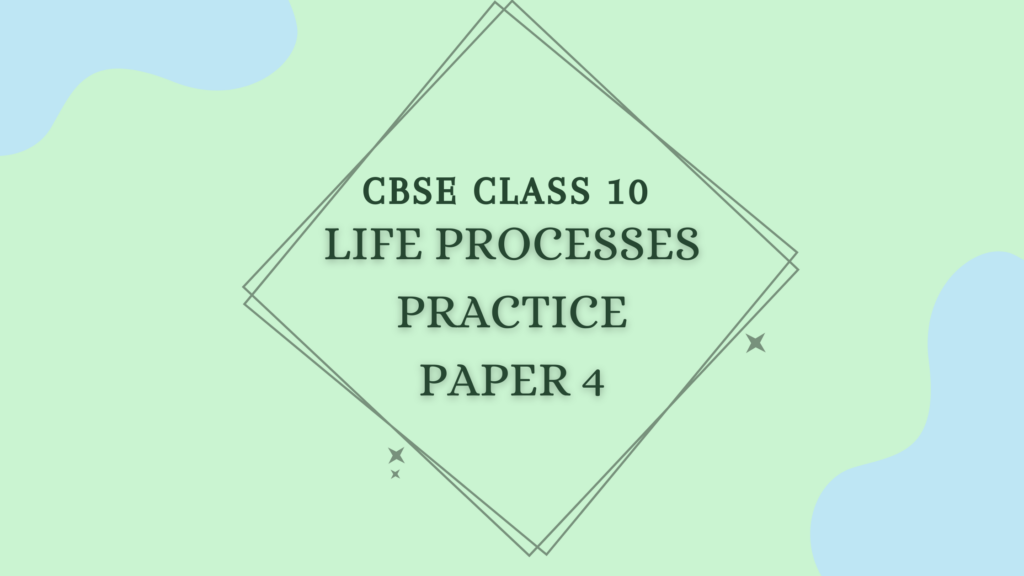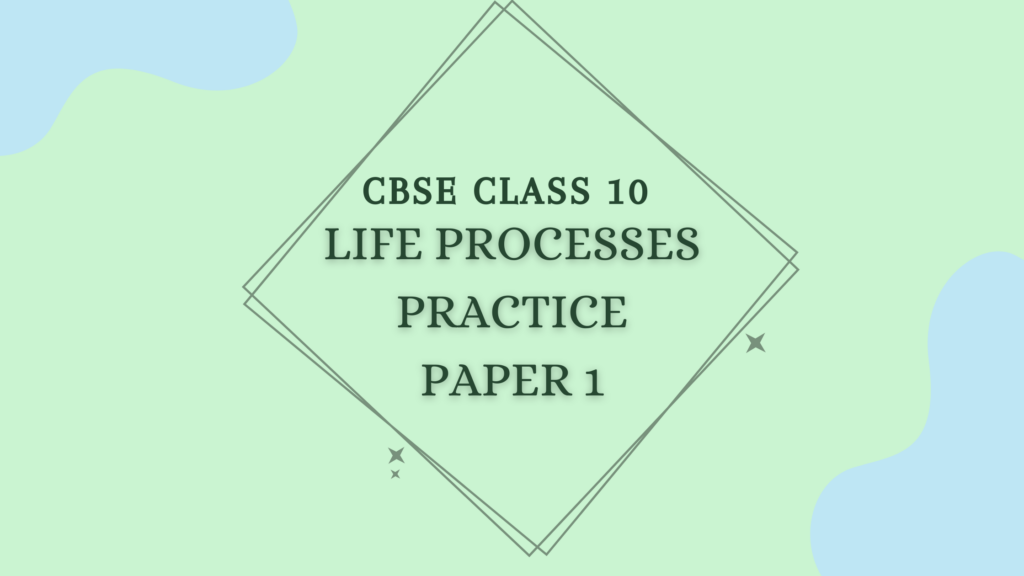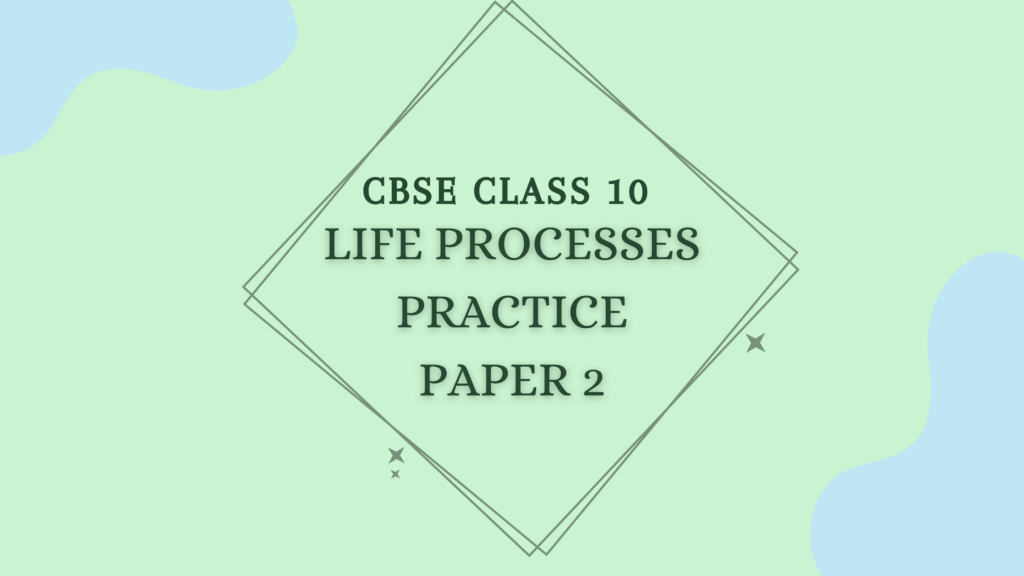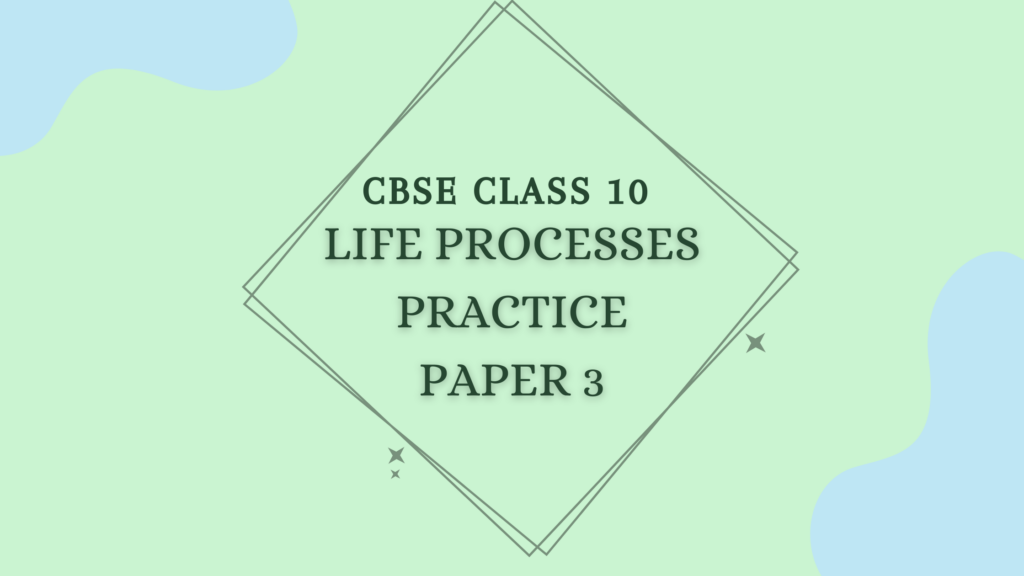Class 10 Life Processes Practice Paper 4
Time: 1 hr
Marks: 30
Section-A Choose the Correct Option 5 x 1=5
1. In which of these organisms is the food broken down and absorbed outside the body?
a) Amoeba
b) Mushroom
c) Paramoecium
d) Lice
2. Organisms that synthesize carbohydrates from inorganic compounds using energy from the sun are
a) Decomposers
b) Carnivores
c) Herbivores
d) Producers
3. What percentage of solar radiation do the green plants absorb for photosynthesis?
a) 10%
b) 8%
c) 5%
d) 1%
4. After a long break from routine exercise, an athlete suffered muscular cramps during a
heavy exercise session. This happened due to:
a) formation of pyruvate due to lack of carbon dioxide
b) formation of ethanol in the presence of oxygen
c) formation of lactic acid due to lack of oxygen
d) formation of carbon dioxide due to lack of oxygen
5. Assertion(A): In plants, there is no need for specialized respiratory organs.
Reason (R): Plants do not have a high demand for gaseous exchange.
(a) A and R are true and R is the correct explanation of A.
(b) A and R are true but R is not the correct explanation of A.
(c) A is true but R is false.
(d) A is false but R is true.
Section-B Very Short Answer Questions 4 x 2=8
6. Why before carrying out the test for the presence of starch in a leaf on exposure to sunlight, is the leaf put in alcohol contained in a beaker and boiled over a water bath?
7. What is the purpose of making urine in the human body? Name the organs that store and release urine.
8. Why do arteries have thick and elastic walls whereas veins have valves?
9. Study the food chain given below and answer the questions that follow:
a) If the total energy available at the third trophic level is 100 joules, then how much energy will be available at the producer level? Justify your answer.
b) Can there be 2 more trophic levels in this food chain before the fourth level? Justify your answer.
Section C- Short Answer Questions 3 x 3 = 9
10. i. What constitutes the central nervous system?
ii. Explain the function of the spinal cord.
iii. How is the spinal cord protected?
11. a. A doctor has advised Sameer to reduce his sugar intake and do regular exercise after checking his blood test reports.
- What is Sameer suffering from?
- Which hormone is responsible for this disease?
- Name the organ that produces the hormone.
11b. Which hormone is present in the areas of rapid cell division in a plant and which hormone inhibits the growth?
12. a. Define excretion.
b. What is the basic filtration unit present in the kidney?
c. Draw a neat diagram of the human excretory system in human beings and label the following organs of the excretory system that perform the following functions.
i. Produces urine.
ii. Collect urine from the kidney.
iii. Store urine until it is passed out.
SECTION – D Case Study Questions 2 x 4= 8
13. Read the following and answer the questions.
The small intestine is the longest part of the alimentary canal. It is a narrow tube of about 6 meters that lies coiled in the abdomen. The length of the small intestine varies depending on the type of food animals eat.
(i) Humans are not able to digest cellulose whereas they can digest starch due to
(a) absence of enzyme cellulase
(c) presence of villi
(b) alkaline pH in the small intestine
(d) acidic pH in the stomach.
(ii) Butter is not digested in the stomach as lipase and bile are
(a) released in the small intestine
(c) released in the large intestine
(b) inactive in stomach
(d) absorbed in the stomach.
(iii) Identify the correct statement.
(a) Carnivores have longer small intestine as they eat meat.
(b) Herbivores have shorter small intestine as they eat grass
(c) Herbivores have longer small intestine as they eat grass.
(d) None of these
(iv) Various types of movements are generated by which layer of the small intestine.
(a) serosa
(b) muscularis
(c) mucosa
(d) submucosa
14. Read the following and answer the questions.
Respiration is an energy-releasing enzymatically controlled process. It involves a stepwise oxidative breakdown of food substances inside living cells. The oxidative breakdown of respiratory substrates with the help of atmospheric oxygen is aerobic respiration. Glucose is completely broken down into CO2 and H2O by this process of oxidation and a large amount of energy is produced.
(i) The site of Krebs’ cycle is
(a) peroxisome
(b) cytoplasm
(c) mitochondria
(d) none of these.
(ii) The respiratory pathway that is common in all living organisms is X. It occurs in the Y and produces two molecules of Z. Identify X, Y, and Z and choose the correct answer.
(a) glycolysis, mitochondrion, pyruvic acid
(b) glycolysis, cytoplasm, pyruvic acid
(c) Krebs’ cycle, cytoplasm, acetyl CoA
(d) Krebs’ cycle, mitochondrion, acetyl CoA
(iii) The number of oxygen molecules used in glycolysis is
(a) 0
(b) 2
(c) 4
(d) 6
(iv) The end product of aerobic respiration is
(a) NADH
(b) oxygen
(c) ADP
(d) CO,+ATP + H2O



